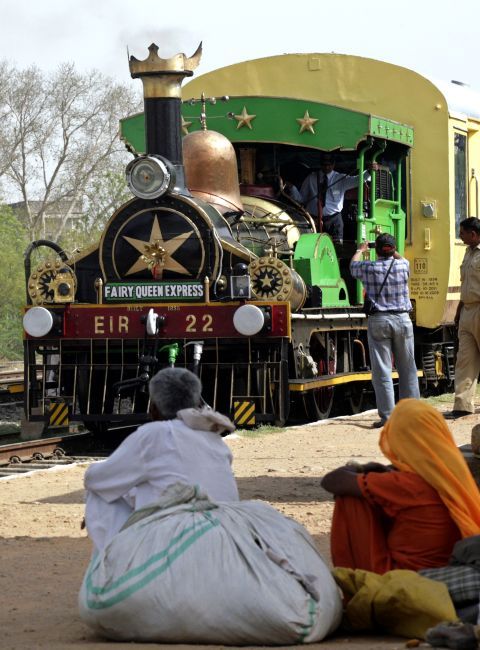 | « Back to article | Print this article |
While we complain about comfort in coaches, rarely do we think about the comfort of engine drivers, points out Bibek Debroy.

When I was a kid, I remember travelling along the hill section of Indian Railways (IR).
The train stopped somewhere and the engine driver, a handkerchief tied around his head and his face covered with soot, came to say hello to my father.
My father went up in my esteem. To kids of that generation, an engine driver was a hero.
I dare say many boys wanted to become engine drivers then, extremely unlikely today.
Have you stood by the side of a railway line at night and seen a train with a steam locomotive thunder past, the red tinge lighting up the driver's face as he shovels coal into the fire?
The age of steam locomotives is over. Every once in a while, a steam engine needed to stop, to top up water and coal, more the former.
Once tenders were introduced, these water stops were needed, say every 100 miles or 160 km. (Before tenders, there were more frequent water stops.)
A stop meant passengers could get down, stretch their legs and purchase food.
Cleaners could get onto the train and clean coaches and toilets. As one switched from steam to diesel/electric traction, these water stops became unnecessary.
In US, there is documentation of ghost towns, created because water stops became redundant.
Sure, every train is not a Duronto, which doesn't have any ticketing stops.
Shatabdis and Rajdhanis also stop, more or less in synch with those water stops. Remember, every 100 to 150 km, there is a junction.
However, there is a difference.
Even if everyone was super-efficient, a water stop would take at least 15 minutes. Shatabdis/Rajdhanis stop for two minutes.
Therefore, food moved from platforms to on-board trains.
To clean coaches/toilets, one needed other solutions. But I want to focus on something else.
As passengers, we continually complain of lack of cleanliness in toilets. Incrementally since the 1870s, toilets have been introduced in coaches, beginning with upper classes.
For instance, the famous Okhil Chandra Sen letter in 1909 is believed to have been instrumental in introducing toilets in lower classes.
I am not sure how many train drivers/loco pilots IR now has. If one includes loco pilots, assistant loco pilots and guards, the number is probably 100,000.
If it is loco pilots and assistant pilots alone, the number is probably around 60,000, my guess being that around 20 per cent of positions are vacant.
While we incessantly complain about comfort in coaches, rarely do we think about comfort in cabs, where loco pilots are.
Think of this. A noise level of100 decibels and more.
A temperature that can shoot up to 55 degrees centigrade. Seats without backrests. Sometimes, seats with terrible designs, so that you need to stand up to drive the train. And, no toilets.
It's true locomotives don't have toilets in them. The sole exception is the WDG5 locomotive, known as Bheem.
A quick word about that alphanumeric combination - W means broad gauge, D means diesel, G means goods train and 5 means 5500 HP.
This diesel locomotive will be used for broad gauge goods trains. But it is still a prototype, it isn't yet operational. The guard's van has a toilet, but not the locomotive.
What do the loco pilot and assistant loco pilot do? As long as there was a water stop, there wasn't much of a problem. As long as it was just mail/express trains, there wasn't much of a problem.
But we now have super-fast trains like Rajdhani/Shatabdi. We have non-stop trains like Duronto, which only stop for technical reasons.
We will have bullet trains. We have already started to have women loco pilots. (Mumtaz Kazi is the first diesel loco pilot, not just for IR, but in Asia.)
In 2013, there was a D P Tripathi Committee to "review duty hours of running and other safety related categories of staff".
This too flagged the issue, suggesting waterless urinals in the interim and full-fledged bio-toilets in the future.
Meanwhile, Indian Railway Loco Running Men's Organization has complained to National Human Rights Commission.
Until this is sorted out, grin and bear it.
Earlier, just behind the engine, there used to be an SLR (second class luggage rake), also called assistant guard's cabin.
The toilet there could have been accessed. But most trains no longer have this.
In superfast trains, there is no through access to passenger coaches, so a loco pilot can't access toilets there either.
In dire emergencies, one can get in touch with the control room and ask for a replacement pilot, at the next stop.
Otherwise, wait for scheduled or unscheduled stops and make a dash for it. The control room might also agree to an unscheduled stop, especially if it is a slow train.
In 2009, there was the incident (at Panbari, near Guwahati) of the assistant loco pilot from Rajdhani Express, who got down to relieve himself on the tracks and was run over by Amritsar Express.
When you see an empty water bottle inside a locomotive, you will now know what this is used for.
Finally, most engine drivers are pretty good at urinating from moving trains. No, not too many boys will want to become engine drivers now.
The writer is a member of the National Institution for Transforming India Aayog. The views are personal.